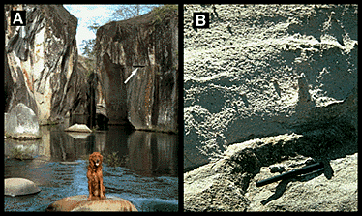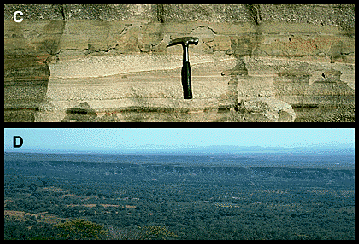Rincon Home Page-->Pre-Rincon Geology-->Liberia Tuff
Field photographs of the Liberia Tuff

A) Liberia tuff (Qlt) exposed 9 km northwest of Liberia in the Rio Colorado (that's Austin for scale). Two main cooling units of this ignimbrite are exposed in the canyon (arrow at cooling break). The Liberia tuff was erupted at approximately 1.4 Ma from a large caldera structure, now largely buried by deposits from the modern volcano.
B) The Liberia Tuff is white to beige, poorly welded, and distinguishable from other ignimbrite deposits in northwestern Costa Rica by its high content of biotite, quartz, and sanidine phenocrysts.

C) Where exposed, the base of the Liberia tuff typically exhibits 2-3 meters of pre-ignimbrite surge and plinian airfall deposits (photograph taken at roadside quarry located at N-98.5, E-76.0 on the Curubande topographic map).
D) View looking SE from the Micro-communications tower (ICE - Canas Dulces) showing an apparent fault scarp in the Liberia tuff. The NW trending scarp is erosional, however, formed by backwasting of the deposit parallel to a NW regional structure trend. The original extent of the Liberia tuff has been estimated by Chiesa (1991) to be 3,500 to 4000 km2, with an erupted volume of 25 km3.
Back to Home Page
Pre-Rincon Geology |
Volcanic Hazards |
Rincon Geology


